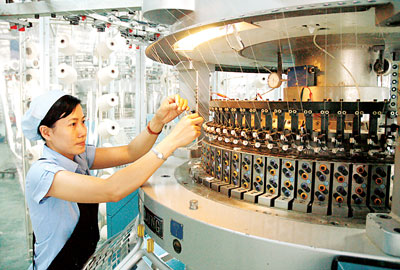|
Chinese
investment in Vietnam
soars
Chinese investment in Vietnam rose to US$2.3 billion in
2013, up sharply from the US$345 million in 2012, according to the Ministry
of Planning and Investment’s Foreign Investment Agency.
Substantially all of the massive influx of investment
in the nation is flowing into the garment and textile and real estate
sectors, causing quite a stir in the arena of public opinion.
Creating a new wave of investment
Recently the Nam Dinh Provincial People’s Committee of
approved the issuance of an investment license to Chinese garment and textile
giant Jiangsu Julun Textiles Group Co.. Ltd to construct a US$68 million manufacturing
facility on an 80,000 sq. m area of the Bao Minh Industrial Park.
When fully operational, the factory specialising in the
production of yarn, will have a total annual production capacity of 9.816
tonnes per annum, suitable for the production of textiles, sewing,
crocheting, knitting and weaving.
Tran Dang Tuong, the principal stakeholder of Bao Minh
IP, said the Chinese manufacturer has an established global reputation and
considerable experience in the industry, which has garnered the interest of
many foreign suppliers who are now eager to form cooperative relationships
with local businesses in the province.
In another promising development, HongKong’s Luenthai
company, the Vietnam National Textile and Garment Group (Vinatex) and China’s
Sanshui Jialida Textile Company held a working session with the leaders of
Nam Dinh province, holing preliminary discussions on constructing a
multi-million garment manufacturing facility in the industrial park (IP).
Covering an area of nearly 1,500 hectares in Nghia Hung
district, Nam Dinh province, the IP project has a total projected initial
investment of US$400 million and with a target market of developing in such
fields as weaving, dyeing, leather, garments and textiles as well as support
industries for Vietnam’s
garment and textile sector. Pending final approval, the project is expected
to begin construction in late 2014.
In recent times, the garment and textile sector has
attracted investment projects from China,
Taiwan, and Hong Kong. Notably, Chinese Texhong Textile Group has
invested in two factories in the southern province of Dong Nai
with capacity of 500,000 spins of yarns and generated 4,500 jobs in the
locality.
Subsequently, the group expanded its investment in Vietnam with
the addition of a US$300 million facility in Quang Ninh province. Within a
year, the project’s first phase has been placed into operation with a
capacity of 500,000 spins of yarns, bringing the group’s total spins of yarns
to one million (equivalent to Vinatex’s yarn factories).
Tuong said that the Chinese garment and textile
businesses are accelerating their investment in Vietnam in anticipation of the
signing of the Trans-Pacific Partnership (TPP) and lucrative additional
market access that comes with it.
Foreign businesses are keenly aware that Vietnam’s
joining the TPP has a number of highly promising and preferences for the
nation. They point specifically to the TPP rule of origin (yarn
forward) which requires businesses to use raw materials, supplies and
components in the manufacturing process that originate in the same country
the manufacturing facilities are located in.
Or, in the alternative, import the items from another
TPP member nation. This rule provides Vietnam a distinct competitive
edge in the garment sector, and is one of the overriding reasons Chinese
businesses find the Vietnamese garment sector highly attractive for
investment.
Enhancing management work
The significant inflow of Chinese investment in the Vietnam
economy has raised an alarm in the minds of many related to an over
dependence on Chinese investment and influence, leading some to advocate
placing limits on the investment.
Bui Xuan Khu, Former Minister of Industry and Trade
said that Vietnam should
welcome all foreign investors to conduct operations in Vietnam,
especially in the garment and textile sector.
Khu stated that over the past ten years, Vietnam has
pursued a garment and textile development strategy. However, the results
remained limited due to outsourcing activities. The production of materials
for the garment and textile sector has not met the export requirements due to
weaknesses in mastering technologies despite modernised machinery and
equipment.
Factually, Vietnam currently imports over 6
billion metres of the fabric to serve the garment and textile sector each
year, while the country has failed to achieve the target of producing even
one billion metres of the fabric over the years.
Khu added that with the new economic developments in
the global marketplace, and in light of the signing of the TPP, Vietnam should welcome the investment inflow,
especially from China, Taiwan and
Hongkong.
These investors will provide the much needed funds to
fuel Vietnam’s
production of raw materials, components and supplies in the garment sector,
generating jobs and taxes to the State, he said.
A significant problem of immediate importance is the
need to improve state management capacity with the supervision of relevant
agencies, so foreign investors are fully informed and ensure compliance with
Vietnamese laws, he concluded.
Source: VOV/VNN
|

Không có nhận xét nào:
Đăng nhận xét